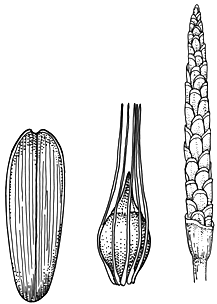Eleocharis dulcis (Burm.f.) Trin. ex Hensch. APNI* 
Description: Tufted perennial with slender rhizomes, sometimes bearing tubers to 10 mm diam.
Culms terete (flatten easily when dried), transversely septate, to c. 1.5 m high, 3–10 mm diam.
Spikelet cylindrical, 25–50 mm long. Glumes very obtuse, striate, with a distinct midrib and hyaline margins, 6–6.5 mm long, straw-coloured. Bristles 6–8, rather stout, flattened and united near base, irregularly retrorsely toothed, about twice as long as nut. Stamens 3; anthers 2.5–3 mm long. Style 3-fid.
Nut turgidly biconvex with angles not ribbed, obovoid, 1.5–2 mm long, 1–1.5 mm diam., golden brown; external cells minute, in no regular series; style base about half as long as and about two thirds as broad as nut.
Flowering: summer.
Distribution and occurrence: North from Murwillumbah area. Also Queensland, Northern Territory, Western Australia, Malesia, Asia. Grows in permanent, more or less still fresh water.
NSW subdivisions: NC
Other Australian states: Qld W.A. N.T.
Morphologically close to E. equisetina, but separable (at least in Australia) on the characters given in the key. Cultivated form is source of commercial 'Chinese water chestnuts'.
Text by K. L. Wilson (1993; revised Sept 2006)
Taxon concept: Flora of NSW 4 (1993)
APNI* Provides a link to the Australian Plant Name Index (hosted by the Australian National Botanic Gardens) for comprehensive bibliographic data
***The AVH map option provides a detailed interactive Australia wide distribution map drawn from collections held by all major Australian herbaria participating in the Australian Virtual Herbarium project.
|


